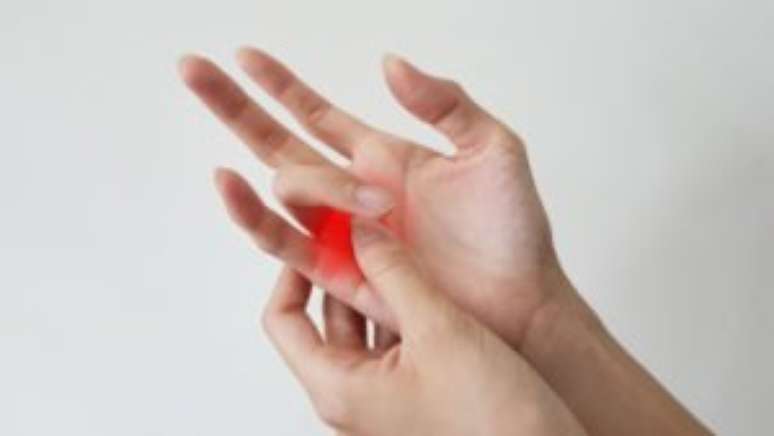Trigger finger causes pain, stiffness, and a feeling of being locked or blocked when the person bends and straightens the finger.
The condition is also known as ‘stenosing tenosynovitis’ and in severe cases the finger may become stuck and be in a flexed position or not bend at all. The ring finger and thumb are most often affected, but it can also occur in the other fingers.
Causes
People whose work or hobbies require repetitive actions such as gripping or who subject their hand to intense vibration or shock are at a higher risk of developing trigger finger, although it is not a direct cause. The condition is also more common in women and people with diabetes or rheumatoid arthritis. Treatment varies depending on the severity.
Symptoms
Signs and symptoms of trigger finger can progress from mild to severe, varying by a few degrees, and include: Stiffness in the fingers, especially in the morning due to fluid buildup and manual inactivity during the night. A popping or clicking sensation when you move your finger.
html[data-range=”xlarge”] figure image img.img-95b04fe208cd55f052ab2bae02c68688otpzacpp { width: 774px; height: 436px; }HTML[data-range=”large”] figure image img.img-95b04fe208cd55f052ab2bae02c68688otpzacpp { width: 548px; height: 309px; }HTML[data-range=”small”] figure figure img.img-95b04fe208cd55f052ab2bae02c68688otpzacpp, html[data-range=”medium”] figure image img.img-95b04fe208cd55f052ab2bae02c68688otpzacpp { width: 564px; height: 318px; }
Tenderness or swelling (lump) in the palm at the base of the affected finger. The finger may get stuck in a bent position, returning to normal with a little more force or sometimes needing assistance from the other hand.
Diagnosis
Clinical tests that take into account the patient’s history are able to close the picture. The opening and closing of the patient’s hands in the orthopedist’s office is sufficient for the diagnosis. Ultrasound can demonstrate the local inflammatory process.
non-surgical treatment
Initial treatment for trigger finger is usually nonsurgical, consisting of physical therapy and home exercises, depending on the severity of the case. The first precaution is to temporarily withdraw from the activity that triggered the problem. The goal is to clear the inflammation and blockage, allowing for full, painless movement of the finger or thumb.
Rest
Resting your hand and avoiding activities that make it worse may be enough to solve the problem.
Cue
Wearing a splint at night to keep the affected finger or thumb in a straight position while you sleep can be helpful in some cases.
Exercises
Gentle stretching exercises can help reduce stiffness and improve range of motion in the affected finger.
Medicines
Medications such as nonsteroidal anti-inflammatory drugs (NSAIDs) and steroids can help relieve pain and inflammation.
Corticosteroid injections
Corticosteroid, is an anti-inflammatory agent in selected doses can be injected into the problem site. A corticoid injection can relieve the symptoms for a time and even resolve the condition, but if the discomfort does not go away or there is a recurrence, surgery may be considered in addition to trying again.
Surgical treatment
If your finger doesn’t get better with nonsurgical treatment, your doctor may recommend surgery. The decision for surgery is based on how much pain or loss of function the person has in their finger. The surgical procedure for trigger finger is called “trigger finger release” or “tenolysis.” The goal is to free the site blocking the movement of the tendon. The procedure can be performed percutaneously (through the skin) under local anesthesia in selected cases or open air, with a small incision of about 1 cm in the palm of the hand and release of the affected tendon by opening its sheath.
Recovery
- Most patients are encouraged to move the finger immediately following surgery if tolerated and carefully.
- It is common to have some pain in the palm. Raising your hand above your heart can help reduce pain and swelling.
- Patients undergoing surgery show significant improvement in function, as well as relief from trigger finger pain within a few weeks.
- If stiffness, swelling, or pain persists after surgery, your doctor may recommend physical therapy sessions for your hands.
Reference: American Academy of Orthopedics
Source: Terra
Ben Stock is a lifestyle journalist and author at Gossipify. He writes about topics such as health, wellness, travel, food and home decor. He provides practical advice and inspiration to improve well-being, keeps readers up to date with latest lifestyle news and trends, known for his engaging writing style, in-depth analysis and unique perspectives.









